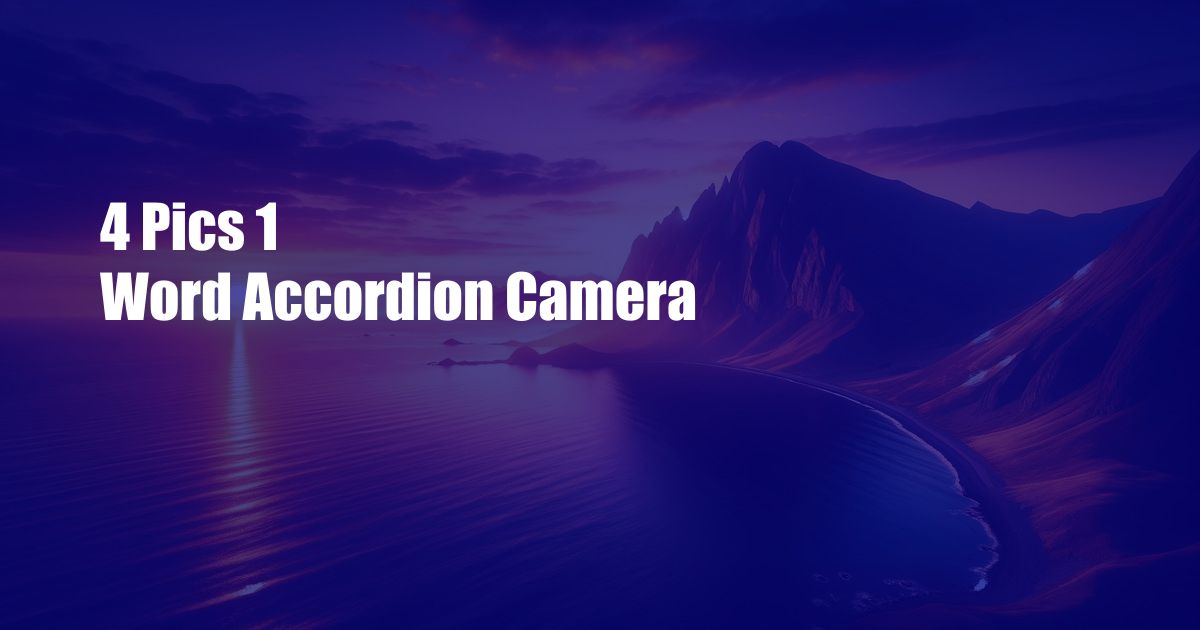
4 Pics 1 Word: Accordion Camera – A Timeless Classic
I remember my grandfather’s old accordion camera. It was a bulky, black contraption with bellows that stretched and compressed as he captured family moments. The images he created were timeless, imbued with a nostalgic charm that digital photos could never replicate.
The accordion camera, also known as a bellows camera, has a rich history that dates back to the early days of photography. Its unique design allowed photographers to control perspective and focus, making it an essential tool for capturing stunning landscapes, portraits, and architectural marvels.
Understanding the Accordion Camera
Accordion cameras are characterized by their bellows, a collapsible, light-tight chamber that connects the lens to the film plane. This bellows provides photographers with the ability to adjust the distance between the lens and the film, enabling them to control perspective and achieve precise focus.
Accordion cameras typically have large format negatives, resulting in high-quality images with exceptional detail and tonality. The bellows also allows for a variety of lens attachments, expanding the photographer’s creative possibilities.
The Evolution of the Accordion Camera
The accordion camera was first invented by Johann Zahn in 1685, but it was not until the mid-1800s that it became widely used by professional photographers. The Kodak No. 1, introduced in 1888, popularized the accordion camera among amateur photographers.
Over the years, accordion cameras have undergone numerous refinements, including the introduction of interchangeable lenses, roll film, and instant film backs. However, the basic design principles have remained largely unchanged, testament to their versatility and timeless appeal.
Tips for Using an Accordion Camera
- Master the Bellows: The bellows is the key to controlling perspective and focus. Learn how to adjust the bellows smoothly and accurately to achieve the desired effect.
- Choose the Right Lens: Accordion cameras allow for a wide range of lens attachments. Experiment with different lenses to explore different perspectives and create unique images.
- Control Light: Accordion cameras typically do not have built-in light meters. Use an external light meter or your knowledge of exposure to ensure proper exposure.
- Use a Tripod: Accordion cameras can be bulky and difficult to hold steady. Use a tripod for increased stability and to prevent camera shake.
- Embrace the Process: Shooting with an accordion camera is a slow and deliberate process. Take your time to compose your shots and enjoy the experience of creating unique and timeless images.
Expert Advice
Renowned photographer Ansel Adams, known for his stunning landscape photography, was a master of the accordion camera. He advised photographers to “use the accordion camera to its full potential, exploring the possibilities of perspective and focus to create images that transcend the ordinary.”
Contemporary photographer Sally Mann, famous for her evocative black-and-white portraits, extols the virtues of accordion cameras for their “ability to create a sense of intimacy and connection between the photographer and the subject.”
FAQ
Q: What is the advantage of using an accordion camera over a modern DSLR?
A: Accordion cameras offer unique capabilities such as perspective control, flexible lens attachments, and the ability to work with large format negatives for exceptional image quality.
Q: Are accordion cameras still relevant in the digital age?
A: Yes, accordion cameras continue to be used by photographers who seek unique perspectives, artistic control, and the timeless aesthetic of film photography.
Q: How much does an accordion camera cost?
A: The cost of an accordion camera varies depending on its age, condition, and features. Used accordion cameras can be found for a few hundred dollars, while new models with advanced features can cost several thousand dollars.
Conclusion
The accordion camera, a timeless classic in the world of photography, continues to fascinate and inspire photographers of all levels. Its unique design provides unparalleled control and versatility, enabling photographers to create stunning images with a distinctive aesthetic. Whether you are an experienced professional or an aspiring enthusiast, embracing the accordion camera can open up a world of creative possibilities.

 Hogki.com Trusted Information and Education News Media
Hogki.com Trusted Information and Education News Media